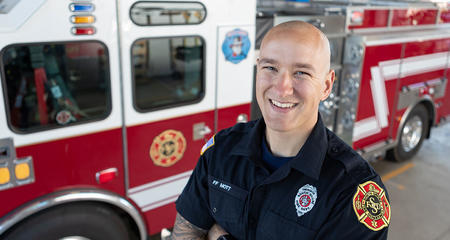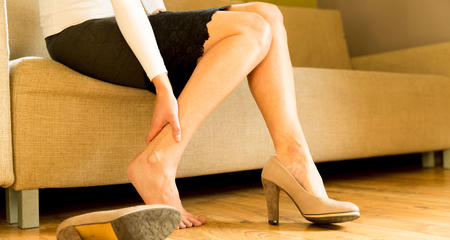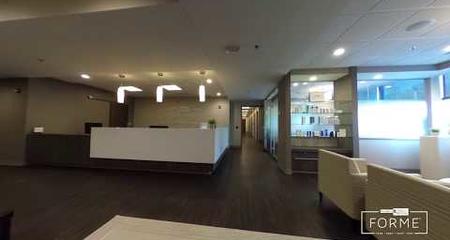Venous disease of the legs is a common condition. An estimated 50 percent of women and 40 percent of men have some type of venous disease. Varicose veins affect roughly half of all people age 50 and older. Many other conditions can increase the risk of developing venous disease.
People with vein disease often experience leg pain or swelling, which can be caused by phlebitis (inflammation), edema (fluid buildup) or a blood clot. Several approaches may be used to treat these conditions. Below are some of the vein conditions treated by our vascular experts.
Spider Veins and Varicose Veins
Our vein clinic at FORME Aesthetic and Vein Center offers the complete range of treatments for all types of varicose and spider veins.
- Varicose veins, commonly found on the legs, are enlarged veins that are visible through the skin and may appear as blue or purple twisted, knot-like cords.
- Spider veins, a milder type of varicose veins, are smaller, red or blue in color, and often look like a “spider web.”
Blood Clots
A prompt and accurate diagnosis is key to treating blood clots, as well as aggressive steps to prevent them.
- Venous Thromboembolism (VTE), Deep Vein Thrombosis (DVT) and Pulmonary Embolism. DVT is a blood clot that develops in a vein deep in the body - most often in the lower legs or thighs, though it may occur elsewhere. A pulmonary embolism is a blood clot (such as a DVT in the leg) that travels to the lung — a life-threatening condition. Developing VTE is a risk after any major surgery, but patients who have surgery of the legs or hips are at higher risk. Treatments for DVT and VTE vary depending on several factors. Thrombolysis, a catheter-based treatment to dissolve blood clots, is one approach. Read more about our advanced DVT and VTE treatment options.
- Phlebitis, Thrombophlebitis. Thrombophlebitis is inflammation or swelling of a vein caused by a blood clot, usually in the leg.
- Superficial Venous Thrombosis. This is a blood clot in a superficial vein (just below the skin’s surface) usually in the upper or lower extremities.
- Thoracic Outlet Syndrome (TOS) and Paget-Schroetter Syndrome. TOS is a group of diseases involving compression of the blood vessels, muscles and nerves between the collarbone and the first rib. Paget-Schroetter syndrome involves a venous thrombosis (clot) at the thoracic outlet.
- Hypercoagulable States (Thrombophilia). Hypercoagulable states refer to the tendency for the blood to clot abnormally. These conditions can be genetic or the result of another medical condition, surgery or trauma. People with hypercoagulable states have an increased risk of developing potentially dangerous blood clots.
Leg Swelling, Poor Circulation and Abnormal Blood Vessels
Conditions other than blood clots can also lead to poor circulation. Leg swelling and other circulatory symptoms should be evaluated right away.
- May-Thurner Syndrome (MTS). Also known as iliac vein compression syndrome, MTS is caused by compression of the iliac vein and can lead to DVT. It is most commonly caused by compression of the left iliac vein between the right common iliac artery and the 5th lumbar vertebrae. This results in symptoms most often occurring on the left side, although compression can also happen on the right. Symptoms include chronic leg pain and swelling — often made worse with activity. Advanced symptoms include skin color changes and severe swelling that interferes with blood flow to the foot. Our team of vascular specialists uses the latest in non-invasive medical imaging to confirm the presence of MTS, including intravascular ultrasound imaging, MRI and CT scans. Treatment options include medication management (blood thinners) and minimally invasive treatment (angioplasty and stenting) to open the compressed iliac vein and keep it open.
- Chronic Venous Insufficiency (CVI). CVI occurs when the leg veins are damaged and blood is unable to circulate back to the heart. Problems with valves in the veins can cause the blood to flow both directions, instead of just toward the heart. This can cause blood to pool. If chronic venous insufficiency is left untreated, pain, swelling, and leg ulcers may result.
- Edema (Leg Swelling). Edema is abnormal fluid buildup in the body that can have many causes. Edema that leads to leg swelling should be evaluated right away.
- Leg Ulcers, Venous Stasis Disease. Poor circulation or a venous obstruction in the legs and lower extremities can lead to venous leg ulcers. Our Vascular Clinic has the expertise and resources to treat leg ulcers caused by venous disease, and many other types of wounds that are difficult to heal.
- Vascular Malformations. These abnormal clusters of blood vessels or defects in the circulatory system are present at birth.
- Genetic conditions — such as arteriovenous malformations (AVM) — can have a variety of symptoms and treatments.
- We are also one of the few centers in the country to treat a related condition, Hereditary Hemorrhagic Telangiectasia (HHT).





